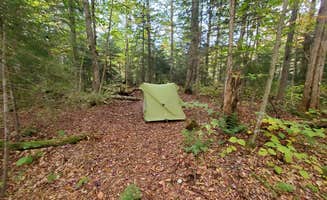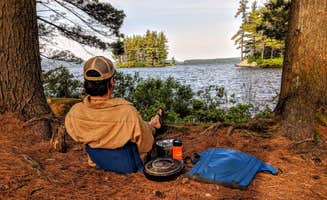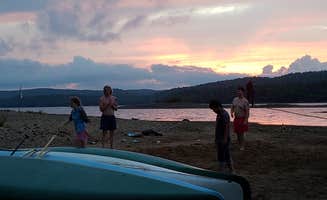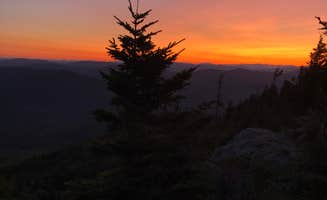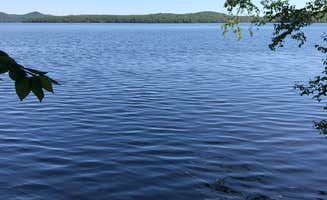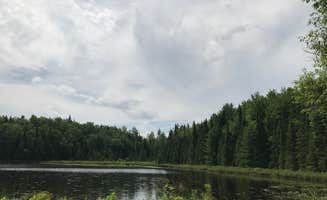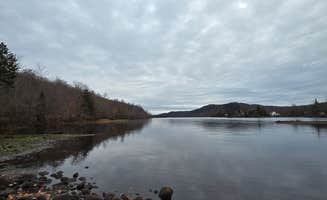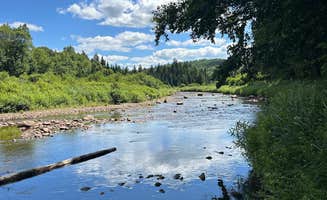Dispersed camping options near Blue Mountain Lake, New York range from waterfront sites requiring boat access to roadside pull-offs accessible by vehicle. The region sits within the Adirondack Park at elevations ranging from 1,700 to 2,800 feet, creating microclimates with temperatures typically 5-10 degrees cooler than surrounding lowlands. Most primitive sites feature uneven terrain with dense tree cover and minimal clearings for tents.
What to do
Paddling exploration: At Seventh Lake Primitive Camping, visitors can access multiple sites via canoe. One camper reported, "We accessed the sites by water on a canoe trip. There is a large sand bar within a very short walk which was a great place to hang out." The area connects to hiking trails, providing a combination of water and land-based activities.
Wildlife observation: Stillwater Reservoir offers exceptional wildlife viewing opportunities with minimal human interference. A visitor noted, "We saw Bald Eagles and Loons, enjoyed swimming, canoing and paddleboarding with the family." Binoculars recommended during early morning and evening hours when wildlife is most active.
Mountain hiking: From Ward Brook Campsite, access trails leading to Seymour Mountain. "Great campsite with a nice lean-to. Fire pit, picnic table, and a privy. A bit further you will find some tent spots too. Plenty of water around," explains one camper. Most trails require intermediate hiking experience and proper footwear.
What campers like
Natural isolation: Campsites at Stillwater Reservoir provide true seclusion with island camping options. A visitor explained, "My wife and I kayaked to Long Island and stayed for a weekend. It was quiet and had the whole island to our self. Would recommend if you want to break away from technology because you get zero service out there." Most island sites require 15-45 minutes of paddling to access.
Private riverside campsites: The Cod Pond Dispersed Pull-Off area offers secluded options with natural sound buffers. One camper described, "Decent site right off of the 'main' road. 'Main' because it was quiet. Easy to access via a short dirt road, but also easy to miss...There was a fire ring and access to the river down a semi-steep bank. Beautiful to listen to at night." Most sites accommodate small to medium vehicles only.
Extended stays: Many dispersed sites allow longer camping periods than developed campgrounds. At Cranberry Lake Backcountry Sites, "We spent 3 nights backcountry camping on Catamount Island in Cranberry Lake and absolutely loved it! The sunsets from the island were truly incredible. Each site has a picnic table and fire ring." Pack adequate supplies for multi-day stays.
What you should know
Vehicle limitations: Many roads leading to campsites have significant restrictions. At Cod Pond Dispersed Pull-Off, one camper warned, "A car is not recommended. Possible to turn around but you definitely need a smaller suv." Allow extra travel time and consider vehicle clearance before selecting sites.
Water sourcing requirements: All dispersed sites require water planning. At Cranberry Lake Backcountry Sites, visitors advise: "You will either need to bring your own potable water or filter from the lake, so don't forget your water filter." Carry minimum 2 gallons per person per day or reliable filtration system.
Insect preparation: Bug populations vary dramatically by season. A camper at Cod Pond noted, "The bugs were terrible." Another visitor to Cranberry Lake mentioned, "While the mosquitoes weren't bad at the campsite itself or while kayaking, they are terrible on the trails this time of year; so bring your bug spray, or better yet, bug shirts!"
Tips for camping with families
Access considerations: When camping with children, boat-accessible sites require additional safety measures. At Seventh Lake Primitive Camping, a visitor explained, "There are a few camping sites and one lean-to that I know of in this area... If you are looking for the site from the water, look for a HUGE rock and there will be a sign that reads camp here." Life jackets required for all children regardless of swimming ability.
Beach features: Some sites include natural sand areas ideal for children. One camper at Stillwater noted their "site had gorgeous waterfront to it, a stone fire circle where someone had left extra fire wood, and ample trees. The season had had unusually low water all over and it left a really unusual landscape on the beach to explore."
Multi-day considerations: Family camping requires careful supply planning. A visitor to Stillwater Reservoir advised, "We borrowed a motor boat to get there this year and brought plenty of gear for 4 days. Weather was great again, some rain each day but we had time to get setup and get shelters to keep dry."
Tips from RVers
Limited RV options: Free camping near Blue Mountain Lake provides few true RV accommodations. At Horseshoe Lake, "Along Co 421, by Horseshoe Lake, there are 10-11 designated campsites. Most have fire pits. Road is rough but easily doable if you take it slow." Maximum RV length typically under 22 feet at most dispersed sites.
Connectivity challenges: Solar and satellite communications face physical barriers. A visitor to Horseshoe Lake mentioned, "As it's a forest, the sites are pretty shaded, so solar and Starlink may present challenges. Slight AT&T at earlier sites." Plan for complete off-grid operation and download maps/information beforehand.


